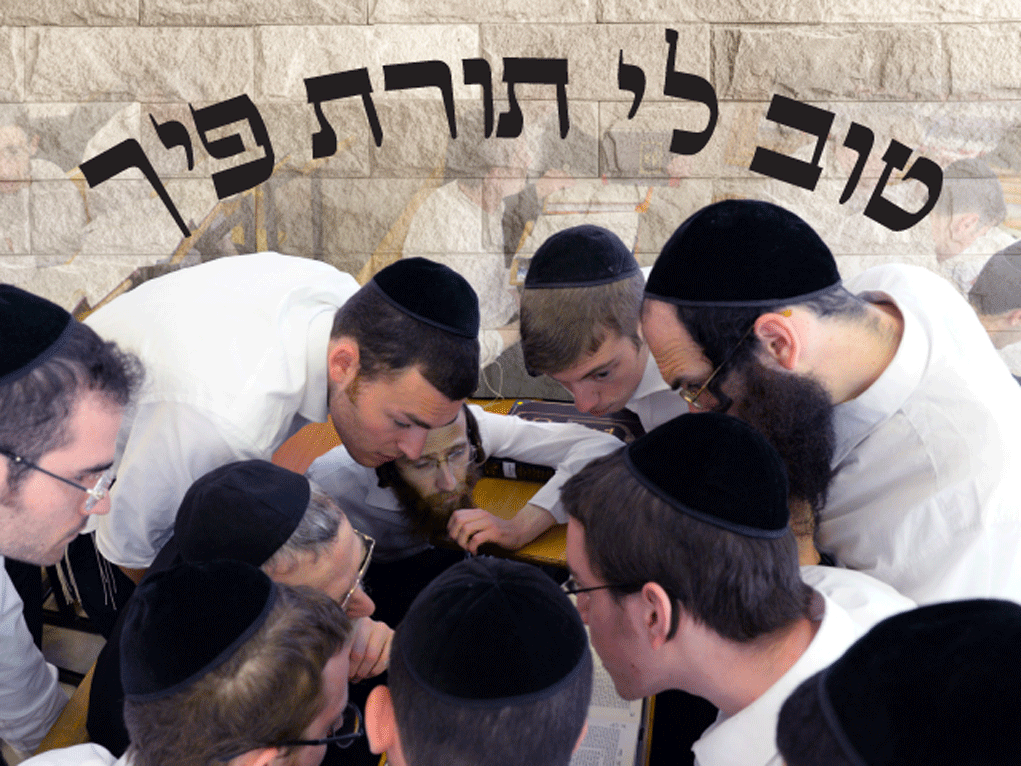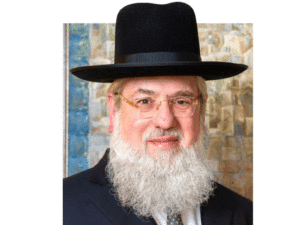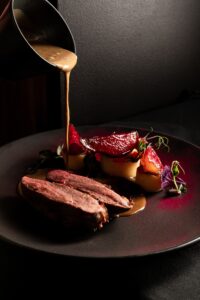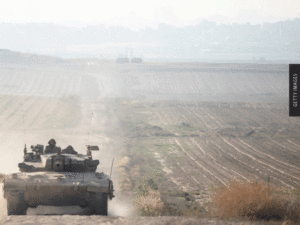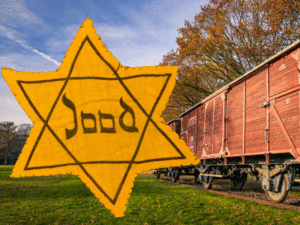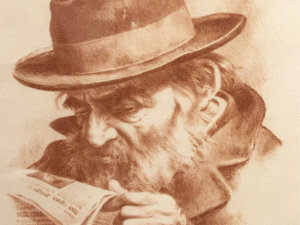Shavuos is the shortest of the three major Yomim Tovim when the Jewish people would make their way to the Bais Hamikdosh. Although the chag has only one day (and two in chutz la’aretz), the world was created for this day, which defines us.
“Kofah aleihem har kegigis.” Chazel tell us that Hakadosh Boruch Hu, so to speak, held Har Sinai over the Jewish people and told them that either they accept upon themselves to study and observe the Torah or He would drop the mountain upon them and they would be buried alive.
Many ask why Hashem forced them to accept the Torah under the penalty of death. Many answers are given. Among them is that the world was created for Torah and for the Bnei Yisroel to be mekabel it. If they would not agree to study and be governed by the laws of the Torah, the world would cease to have a purpose and would be returned to its original inert state.
The path was laid by the avos, Avrohom, Yitzchok and Yaakov, and passed on to the shevotim and to their children. In Mitzrayim, the offspring grew exponentially, but sank to levels of depravity that endangered their ability to continue their glorious heritage.
Before they reached the point of no return, Hashem redeemed them, miraculously removing them from Mitzrayim. They traversed the Yam Suf to escape the clutches of decadence and immorality and began the trek back to the hallowed path of their forefathers.
After 49 days of preparation, they were ready to fulfill their destiny and be delivered the Torah. They recited the immortal words, “Naaseh venishma,” accepting upon themselves the Torah’s obligations and set the world on its proper trajectory.
At that moment, Klal Yisroel proclaimed that although they were mortals fashioned of flesh and blood, they were willing to live on a higher and loftier plane, with the Torah as their guide.
Malochim had objected to the notion of giving the Torah to humans, but after the Bnei Yisroel demonstrated their worthiness, the angels affixed crowns to their heads (Shabbos 88a). There are different interpretations as to what the crowns consisted of, what their significance was, and what they accomplished. Most likely, they did not resemble the adorable golden paper crowns that children wear to celebrate Shavuos and the receipt of their siddurim and Chumoshim, but those crowns keep the message alive and remind us of the heights we reached and can attain even in our day.
Shavous contains the power and potency evident on the day 3,333 years ago, when the Torah was first given to us. Every year, on chag Mattan Toraseinu, the gift that was first given at Sinai is regifted to those who have undertaken the proper preparations and made themselves worthy. Even in our day, when tumah is all around, there is kedusha among those who are able to keep themselves immune to prevalent depravity and armed against the constant threats to our fundamental inbred decency.
The further a person is removed from Torah pursuits, the more he is assaulted by tumah, stupidity and ideas that weaken his inherent goodness. These are not necessarily solely relegated to foreign and secular platforms. The yeitzer hora has succeeded in tainting our souls while hiding in plain view and using familiar words and concepts in places people feel safe.
On Shavuos, we remain awake studying Torah to demonstrate that Torah rules over everything physical. There is no sleep and no fatigue on the eve of Kabbolas HaTorah, for the Torah is what energizes us and gives our lives meaning.
The Meshech Chochmah at the end of Parshas Yisro writes that until Mattan Torah, people were only able to serve Hashem through ruchniyus. When the Torah was given, acts that were previously purely gashmiyus and physical were invested with kedusha. Upon the acceptance of the Torah, people were empowered to sanctify themselves and all human needs and instincts.
That is why Hashem told Moshe Rabbeinu at the s’neh, the burning bush, “She’al na’alecha mei’al raglecha – Remove your shoes from your feet.” He was saying, “Remove the vehicles for your gashmiyusdike physical lives as you approach Me.”
Prior to Matan Torah, only angels could approach Hashem. After Matan Torah, Hashem told the Jewish people, “V’anshei kodesh tihiyun li – And you shall be holy people” (Shemos 22:30). This means exactly what it says: to be people and to be holy while living as people.
The Torah doesn’t ask, or demand, of us to be malochim. It wants us to function as people, doing what people do, but being on an elevated Torah level. We need to be good people, functional parents, siblings, spouses and friends, who are holy as we follow the Torah and continuously grow and excel.
On Shavuos, we celebrate this concept. Hashem gave us the Torah to guide us humans as we exist and thrive in this world. We appreciate the potential of what we can achieve and of the heights we can reach by delving into Torah and dedicating ourselves to all it commands us to do. But through it all, we remain human, anshei kodesh – human, but holy. The two are not mutually exclusive.
The Gemara states that while regarding other Yomim Tovim the rabbis disagree how much of the day should be dedicated to the purely spiritual, on Shavuos “hakol modim deba’inon nami lochem.” They all agree that we need to please the more physical side, as well.
We can understand this to mean that on Shavuos, we need “lochem,” to proclaim that the physical is part of the Shavuos celebration. We demonstrate through our actions that Torah has affected and touched our base desires as well.
Chazal (Pesikta Zutrasa, Va’eschanon) state, “Chayov odom liros ess atzmo ke’ilu mekabel Torah miSinai, shene’emar, ‘Hayom hazeh nihiyeisa le’am.’ Every day a person is obligated to conduct himself as if he accepted the Torah that day at Har Sinai.’” We are all familiar with this directive regarding Yetzias Mitzrayim. In fact, it is the central theme of the leil haSeder. We don’t think about it on Shavuos, however, and it may be news to some of us.
Imagine if today were the day you received the Torah. Imagine standing at Har Sinai and hearing the words of the Aseres Hadibros being recited for all to hear on the loudest loudspeaker imaginable. Imagine all the other sounds. Imagine the sight of all the Yidden standing at the mountain, their neshamos – and yours – rising to unprecedented heights. Imagine leaving Mitzrayim knowing little about your heritage or holiness and becoming a better person every day as you walked through an arid desert.
Then imagine how empty and meaningless your life would be without Torah. No Torah, no learning, no davening, no Shabbos, no tefillin, no Yom Tov, nothing that your life is centered around, nothing that gives your life the value and meaning it now has. You wouldn’t have a shul to go to and would have no reason to go to one altogether. Think of everything you do in your day, week and year. Now imagine that there was no Torah. It is what gets us out of bed in the morning and makes our lives worth living.
Without it, life is an empty daily jumble of meals, posts, clips, silly chats and other banal trivialities. And when its all over, such people are left empty, bored and without meaningful substance.
Imagine that you came from that world and today is the day you discovered the Torah. Imagine that today you were invited to study Hashem’s word, to bask in His glow, to find meaning, satisfaction and joy in your life. How excited you would be! How grateful and how dedicated!
Today is that day. “Ke’ilu mekabel Torah miSinai.”
Appreciate it. Show it. Feel it.
Hayom hazeh! Today and every day. Despite the degeneration of the world, despite the struggles we experience with every tefillah and the challenge of concentrating fully when we learn, despite the many forces competing for our attention, we have a new Kabbolas HaTorah.
Human shortcomings are but a hindrance that we can overcome.
In times of old, this concept was widely understood. There was a natural reverence for Torah and its scholars even among the unlearned. In Volozhin, local homeowners would line up at the train station before each zeman to vie for the honor of pulling the wagons carrying arriving talmidim and their luggage. The yeshiva learned through Shas, and when the yeshiva celebrated a siyum, the local people would arrive at the yeshiva. They didn’t come to partake in a great feast; I doubt that there were any of the delicacies that we enjoy at a simple Kiddush these days. They came because they wanted the honor of serving those who were marking a milestone in the Torah study. They were the waiters.
Imagine that taking place nowadays. The yeshiva would hold a festive party, the bochurim and yungeleit would celebrate their great achievement with a festive meal, and the upstanding members of the community would go from table to table dispensing the food and cleaning up after.
Nobody asked them to come, they would come on their own. Theof Volozhin would come to the siyum because they appreciated Torah and lomdei Torah. It was their distinct honor to carry the lomdei Torah and their belongings to the yeshiva, and it was their pleasure to partake in the simcha of the completion of yet another masechta by serving as the waiters.
It was special to them. It was valuable to them, as if it was given today. They treated it with respect. They treasured the Torah and the people who studied it. It was their pride and joy.
We hear these things and smile. They are charming reminders of a world that was. Of a world that we should be looking to recreate.
Shavuos is a time to refocus on what Torah means to us and on how blessed we are to be able to spend time by a Gemara or Chumash or Shulchan Aruch, surrounded by more talmidei chachomim and yeshiva bochurim than there have been since the days of Sura and Pumpidisa.
The Klausenberger Rebbe arrived in America after the Second World War having lost his wife and eleven children. He married a daughter of the Nitra Rov. Rav Leizer Silver, the legendary rov of Cincinnati and one of the most prominent rabbonim in America of those years, was a special guest at the second sheva brachos, which was held in Mount Kisco. As he rose to speak, he announced that he came bearing a gift for the chosson and kallah, a check for two hundred and fifty-eight dollars.
“If you wonder how come I am giving that amount, I’ll tell you,” he said. “It’s because that check represents everything I had in my bank account. Every last penny. The rebbe is a talmid chochom and he will produce talmidei chachomim. I would give everything to be part of that. I wish I had more to give!”
The speech of the quintessential Litvishe rov resonated with the crowd. They got his message about what would yet be and the glorious future that America might have as a makom Torah. He was telling them not to despair, not to give up, and not to say, “It can’t happen here.”
Moreover, he was saying, “We are still here, holding on to Sinai, and as long as we cherish and revere and support those who learn and teach Torah, we have a future.”
We open our arms wide and accept the Torah just as those who came before us have done for thousands of years. We cherish its words, raising our children and helping guide them to see the honey under each letter.
It is who we are and what we are about. Our lives revolve around it. It is Torah.
With our feet dragging through the dust of life, of temptations, of parnossah and health challenges, we persist in walking with our eyes on Him and on His Torah, knowing that it is meant for us, to give us the tools to climb higher.
Modim anachnu loch shesamta chelkeinu m’yoshvei bais hamedrash. Thank You, Master of the universe, for allowing us to have a connection with Torah, to have tasted the truest joy of all.
We are the most blessed people, living in the most blessed time. Let us show Hashem, our families and ourselves that we appreciate all that we have been given to be able to realize our purpose in this world.
Let us demonstrate that we are worthy of all that we have and use what Hashem has given us to enhance our own lives and those of our families and those around us. Let us show through our actions that we strive to become holier and better.
On Shavuos and all year round, let us get closer to Torah, learning better and on a deeper level so that it touches our souls and brings us closer to where we were at Har Sinai.
We can get there.
When the Bnei Yisroel who had gathered to receive the Torah proclaimed, “Naaseh venishma,” 600,000 malochim came down to earth and tied two crowns onto each person, one for naaseh and the other for nishma. When they sinned with the Eigel, 120,000 angels of destruction came and removed the crowns.
Rav Dovid Cohen, rosh yeshivas Chevron, in his sefer Biurei Chochmah (page 75), quotes from from the Leshem that the malochim only removed the crowns that were tied to the Jews’ “guf and chomer,” but the crowns remain in the “neshamos and penimiyos” of the Jewish people.
Without getting into the depths of what that means, what we can understand is that those crowns still adorn our souls, and “inside” we are and shall remain holy. Let’s not put ourselves down. Let us not say that we can’t reach those heights. Let’s not say that we can’t be holy and can’t be expected to be holy. We are and we can be.
We have been through a lot, especially over the past few days. Let’s show what we’re made of. Let us show that we are tough and good and holy.
Gut Yom Tov.
